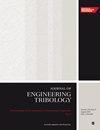Wear mechanism and leakage failure analysis of the mechanical seal end face of an oil transfer pump
IF 1.8
3区 工程技术
Q3 ENGINEERING, MECHANICAL
Proceedings of the Institution of Mechanical Engineers, Part J: Journal of Engineering Tribology
Pub Date : 2023-10-16
DOI:10.1177/13506501231206696
引用次数: 0
Abstract
The John Crane 48 V mechanical seal is a long-distance oil transfer pump station shaft end seal; its sealing effect directly affects pipeline production safety. However, it has been found that there is oil leakage at the shaft end of the pump station. In order to explore the oil transfer pump mechanical seal abnormal leakage failure causes, to ensure the safety and stability of production, the end face of the 48 V mechanical seal was analyzed by white light interference and scanning electron microscope technology. The failure mechanism of the 48 V mechanical seal was explored from the perspective of the wear mechanism of moving and stationary rings. Results showed that the wear mechanism of the 48 V mechanical seal stationary ring was mainly abrasive wear, and substantial furrows, bulges, and depressions existed on the wear surface. The material removal mechanism was brittle spalling, and the roughness of the wear surface increased with the increase in wear depth and decreased with the increase in wear average width. Uneven wear occurred on the end face of the stationary ring of the mechanical seal, resulting in the leakage of the sealing medium from the end cover of the mechanical seal. The working condition could be improved by adding a spring compensation device to the stationary ring or increasing the gap between the stationary ring and the shaft sleeve.油泵机械密封端面磨损机理及泄漏失效分析
约翰克兰48v机械密封是一种远距离输油泵站轴端密封;其密封效果直接影响管道生产安全。但发现泵站轴端有漏油现象。为了探究输油泵机械密封异常泄漏故障原因,保证生产安全稳定,采用白光干涉和扫描电镜技术对48 V机械密封端面进行了分析。从动环和静环磨损机理的角度探讨了48v机械密封的失效机理。结果表明:48v机械密封静环的磨损机制以磨粒磨损为主,磨损表面存在大量的沟、凸起和凹陷;材料的去除机制为脆性剥落,磨损表面粗糙度随磨损深度的增加而增大,随磨损平均宽度的增加而减小。机械密封固定环端面发生不均匀磨损,导致密封介质从机械密封端盖泄漏。可通过在静环上增加弹簧补偿装置或增大静环与轴套之间的间隙来改善工况。
本文章由计算机程序翻译,如有差异,请以英文原文为准。
求助全文
约1分钟内获得全文
求助全文
来源期刊

CiteScore
4.20
自引率
5.00%
发文量
110
审稿时长
6.1 months
期刊介绍:
The Journal of Engineering Tribology publishes high-quality, peer-reviewed papers from academia and industry worldwide on the engineering science associated with tribology and its applications.
"I am proud to say that I have been part of the tribology research community for almost 20 years. That community has always seemed to me to be highly active, progressive, and closely knit. The conferences are well attended and are characterised by a warmth and friendliness that transcends national boundaries. I see Part J as being an important part of that community, giving us an outlet to publish and promote our scholarly activities. I very much look forward to my term of office as editor of your Journal. I hope you will continue to submit papers, help out with reviewing, and most importantly to read and talk about the work you will find there." Professor Rob Dwyer-Joyce, Sheffield University, UK
This journal is a member of the Committee on Publication Ethics (COPE).
 求助内容:
求助内容: 应助结果提醒方式:
应助结果提醒方式:


